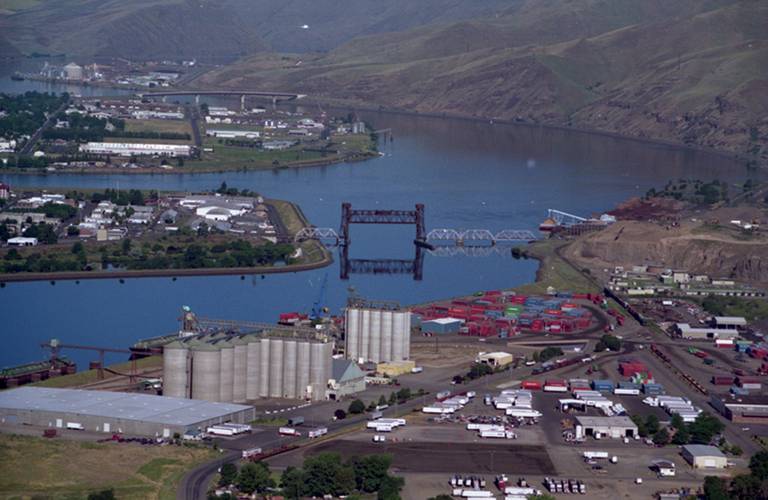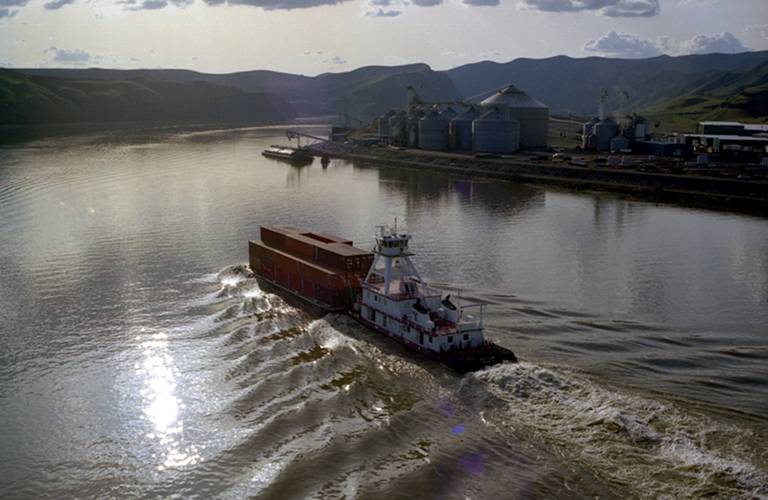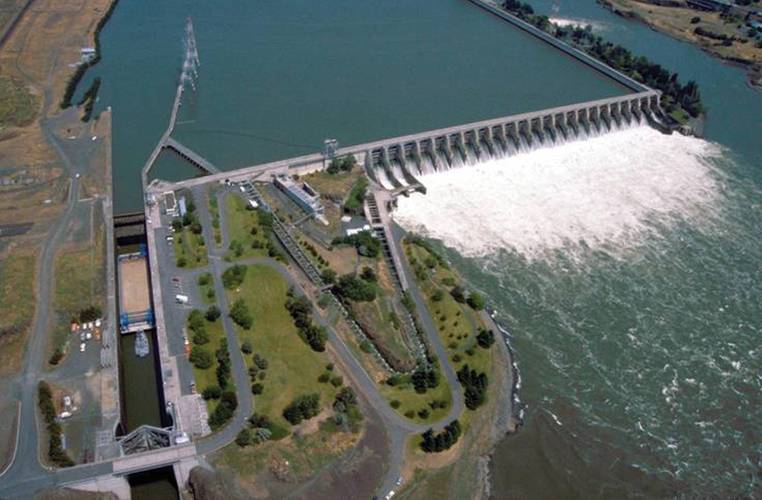Real Marine Highways for Real Intermodal Solutions
The Columbia/Snake River System defines shortsea shipping, and promises much, much more.
Lewiston, Idaho, is perhaps best known to tourists as the turnaround for a Columbia River cruise or the jumping-off point for a trip to Hell’s Canyon, North America’s deepest gorge. For anyone transporting cargo, however, it’s known as the port farthest inland of any on the West Coast – a whopping 465 miles inland from the mouth of the Columbia River. Located close to the border between Washington and Oregon, Lewiston, Idaho’s only port, advertises itself as “strategically located” at the far Eastern end of the extensive Columbia/Snake River system. Even then, they may be selling themselves a little short.
America’s Marine Highway, West Coast Style
Ocean-going traffic can range 145 miles up to the Bonneville Lock, 40 miles East of Portland, Oregon. From there, a 14-foot channel goes to Lewiston, elevation about 700 feet. A typical barge on the system is 42’ wide and 274’ long. Usually, towboats handle as many as four in a given trip, and containers are a frequent cargo for these journeys. Barging also works well for transporting bulk commodities like wheat, and the river system is a prime transportation artery for agricultural commodities. The Pacific Northwest ranks first in the United States for wheat and barley export. Beyond this, the Columbia/Snake River system leads the West Coast for wood exports and is first on the West Coast for mineral bulks and second on the West Coast for automobile imports.
“We are an export heavy system, and play an important role in balancing the nation’s trade deficit,” said Kristin Miera, Executive Director of the Pacific Northwest Waterways Association (PNWWA). The system is well established and the overall amount of cargo transported has remained stable over the past ten years, said Miera. Annually, PNWWA says that ten million tons of commercial cargo valued at three billion dollars passes annually over this inland waterway.
Including deep draft as well as well as inland cargo, the amount of cargo moving on the entire Columbia/Snake River system in 2011 was 44 million short tons. Miera added, “Please note that this is the number associated with the deep draft as well as inland cargo. Some deep draft cargo does not originate from the inland system, and instead arrives at the deep draft facilities via rail or truck.”
The Port of Portland, through which almost all cargo goes, reported a container total for 2013 as 178,451 TEU (twenty-foot equivalent units), Miera said.
Half of all wheat exports arrive by barge. Twenty-five grain elevators in this large farming region with its highly developed river keep barge transportation very competitive. In turn, low costs allow growers to price commodities at levels comfortable for export markets. In 2012, EGT, a state-of-the art grain export facility was opened in Longview, Washington, not far from the mouth of the Columbia. EGT’s facility is the first export grain terminal built in the U.S. in 25 years.
Barge Transport & Efficient Agriculture Export
Miera emphasized the social positives of barge transport, “We know that barging is good for the environment and for people. There are fewer spills associated with barging, and fewer accidents and fatalities. A typical 4-barge tow on the Columbia Snake River System is the equivalent of about 140 rail cars, or 538 trucks on the highway.” He added, “We strongly support rail, trucking and barging – all three must be maintained and efficient for cargo to flow. Take away one entire mode, and there will be significant impacts to the other two.”
At the far Eastern end of the river system, the region of rolling hills and deep soils known as “the Palouse” is famous for its soft white wheat, which is used for crackers and noodles in Asian countries. Farmers grow soft white wheat, peas, lentils and garbanzo beans, also known as “pulses.” As much as 80 percent of regional agriculture production is exported. Lewiston’s Port Manager David Doeringsfeld said, “The majority of what we ship is paper products manufactured by Clearwater Paper; peas and lentils grown in the area; and container loads of wheat. Everything we grow within a hundred miles radius is exported overseas. The port allows us to cater to export markets.”
“We move a lot of bulk grain shipments out of here. Bulk wheat shipments are the main commodities shipped on the Columbia/Snake River system.
These grain shipments are what allow containers on barges to be cost effective. Because you’re moving these grain barges up and down river all the time, it’s then cost effective to just tie in a container barge into that tow,” he said.
Port of Lewiston: Expanded and Improved
In the past, the Port of Lewiston had space for only one barge at a time at its dock, but after recent improvements, two barges fit comfortably. Now, said Doeringsfeld, “We’ll be able to load one while we’re unloading another. It also opens up some ‘break bulk’ opportunities. Lewiston’s dock is 250-feet long and capable of handling any roll-on/roll off cargo allowed on area highways. Even before the expanded dock, the Port of Lewiston was working with U.S. and Canadian companies and logistics firms to handle oversized cargo bound inland. For example, refinery equipment has gone to the Kearl Oil Sands in Alberta, Canada. Wind generators have made their way to the U.S. Midwest and parts for coal-fired electrical generation plants into Wyoming.
Significantly, Lewiston lies less than 800 miles by road from the Sidney, Montana and Williston, North Dakota area and may be a less-expensive alternative route to the oil fields. In the past, shipments of pipe manufactured in Asia have gone through the Panama Canal and then up through Houston to oil producing areas. Lewiston and the Eastern Oregon ports of Umatilla and Morrow are looking for more oversize loads.
Lewiston is versatile, as well. The long dock at the Port of Lewiston has also been used to send shipments downriver. An Idaho company manufactured a load of 39 modular dorms and put them onto a 400-foot-long, 76-foot wide ocean going barge twice as big as most of the barges that call on Lewiston.
The barge took the dormitory parts all the way to Seward, Alaska without stopping to switch to a bigger boat. They became a three-story dormitory for Alaska Vocational Technical College in Seward.
Opportunities and Impediments
Oversize can mean as much as 24 feet wide, 20 feet high and 150 feet long. The long dock is just as useful for moving anything else that needs to get to the oil fields, so shipments might, said Doeringsfled, “also include compressors and pumps that would be a normal shipment on a tractor-trailer unit. You could have all different types of supplies.” He added, “We recognize that we have opportunities now with the exploration for oil in North Dakota and Alberta that will provide a market for shipping on this river system for years to come. We recognize this opportunity.”
Nevertheless, there have been political objections to moving the giant loads on a highway close to Lewiston, Highway 12, which parallels a Wild-and-Scenic-designated river. However, there is more than one route. Doeringsfeld said he is optimistic about future shipments. Kim B. Puzey, General Manager of the Port of Umatilla and current president of the PNWWA, said that his port has just replaced a crane built in 1940 and would also be interested in the oversized loads.
However, he said, it is hard to tell how many loads there might be. “It could just be a spike. For the port, it’s just a big, heavy piece of steel. The tar sands in Alberta, Canada are a big find, just like the Baaken oil fields in North Dakota,” he said. “If there are protests, then they’ll just make a decision to build them onsite. It works for their interests, then something changes, the price of fuel, there are all kinds of variables.”
HMT: The 600-Pound Gorilla in the Room
The Harbor Maintenance Tax (HMT) applies in the Northwest as it does in other parts of the country. PNWWA’s Meira describes it as a tax that “hampers short sea shipping because any landed cargo which is then loaded onto a short sea cargo is taxed a second time. Hence, HMT discourages use of waterways for short sea voyages, forcing cargoes onto the rails and highways for purely economic reasons.”
Federal lawmakers, especially those representing the Pacific Northwest, haven’t been sitting on their hands. Senators Patti Murray and Maria Cantwell of Washington, in September of 2013 introduced “The Maritime Goods Movement Act for the 21st Century” to replace what they call the “outdated Harbor Maintenance Tax” which, they say, “currently incentivizes shippers to bypass American ports and move U.S.-bound goods through Canada and Mexico instead.”
The bill replaces the HMT with the Maritime Goods Movement User Fee, which, they say, “would discourage shippers from diverting American-bound goods through Canadian or Mexican ports simply to avoid American taxes that fund vital infrastructure investments and keep American ports competitive in the global economy.”
Separately, John McCalla, president & CEO, Omega Morgan, specialists in large-scale moving operations, said, “The ports along the Columbia and Snake River continue to offer Omega Morgan opportunities to ship right sized cargo into the Midwest and Canada. The outlook for 2014 and beyond remains strong for continuing use of the routes leading from those ports.” That’s the quintessential definition of shortsea shipping: alive and well on America’s West Coast.
(As published in the March 2014 edition of Marine News - www.marinelink.com)






















